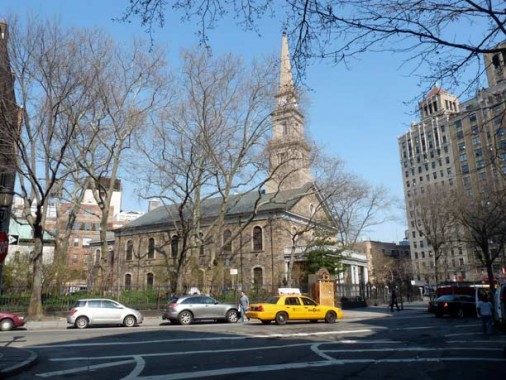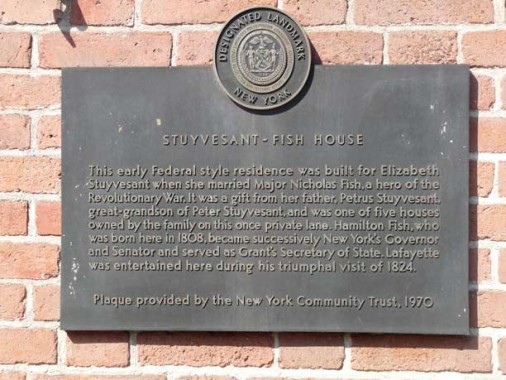Back in 1999, the Dawn of Forgotten New York, I did a page on Stuyvesant Street, one of the very few routes that flouts New York City’s strict street grid (which celebrated its bicentennial in 2011). I explained its former role as the driveway to the Stuyvesant estate, and why and how it survived.
A couple of weeks ago [March 2012] I had lunch in the East Village area and then wandered over to Stuyvesant Street, which always seems to attract me like a magnet. Then I went home and cracked the Internet–I seem to discover a little bit more about this picturesque diagonal every time I’m there. To me, it’s New York’s smaller enclaves that give it character — they are relatively rare in comparison to other older cities like Philly or Boston (I also want to investigate places like Newark, Trenton, Wilmington and get a feel for those places from their alleys.)
The northeast end of Stuyvesant Street affords a view of St. Marks-in-the-Bowery, an Episcopal church built in 1799 (the steeple dates to 1829). The difference in dates accounts for its melding of 3 different architectural styles, Federal for the church, Greek Revival for the steeple, Italianate for the portico, added in 1854. The burial vault of Peter Stuyvesant (1612?-1672), the last Dutch Director-General of New Netherland, can be found in the churchyard. Though Stuyvesant died nearly a century before the church was constructed, his family owned property in the area including a farm and a chapel. Daniel D. Tompkins, NYS Governor from 1807-1817 and US Vice-President from 1817-1825, is also interred here, as is Philip Hone, NYC mayor from 1826-1827 and later a prolific diarist. The church was nearly destroyed by fire in 1978, but was rebuilt by the mid-1980s.
I think Stuyvesant, a strict Dutch Reformist, wouldn’t be thrilled to know he rests on property that derives from the Church of England.
Nicholas Fish-Elizabeth Stuyvesant House, 21 Stuyvesant. As the historic plaque explains, it was constructed in 1804 by Petrus Stuyvesant as a gift for his daughter when she married Revolutionary War hero Nicholas Fish, who served with Washington at Valley Forge and at age 18 is still the youngest Major in US Army history. He was associated with Treasury Secretary Alexander Hamilton and the Marquis de Lafayette, whose military expertise helped win the war. Lafayette visited NYC in 1824 and was entertained in this building.
Nicholas and Elizabeth’s son Hamilton was born here in 1808. He went on to serve as US Senator, Governor of NY State, and US Secretary of State under U.S. Grant. The Fish name has long been prominent in NY State politics.
Inside the building many original features have survived testifying to its authenticity – the stairway, the archway in the hall, coiling decorations and the side windows that were used when the house was first built and had no adjoining building to the east. The exterior of 21 Stuyvesant Street is a hallmark of the Federal style; above the windows are the original splayed stone lintels. On the top floor of the house are two early arched dormer windows; at the centor of each arch is a double keystone and the top sash has been replaced. The Stuyvesant-Fish House stands today as an all but unique example of a fine New York urban dwelling of the period. NYC Landmarks Report, 1969
I had long believed that St. Mark’s Church and the Nicholas-Fish House were the oldest buildings on the block. However, 44 Stuyvesant was built in 1795 for Nicholas William Stuyvesant, according to Landmarks, and is one of two remaining houses that belonged to the Stuyvesant family from the immediate post-Revolutionary era. Only the Morris-Jumel Mansion in Sugar Hill is an older residential building on Manhattan Island. It carries no historic plaque and blends in well with the surrounding buildings, which go back to the 1840s-1850s.
Abe Lebewohl Triangle, Stuyvesant Street and East 10th. The longtime owner of the 2nd Avenue Deli (he founded it on the SE corner of 2nd Avenue and East 10th in 1954) was shot and killed in an unsolved robbery on March 4th, 1996. The deli closed at its original location, but later reopened in two Midtown and East Side locations, 162 East 33rd and 1442 1st Avenue.
Stuyvesant Street’s collection of row house apartment buildings, #23-35, along its north side were constructed in 1861. The land had originally belonged to the descendants of the Nicholas-Fish property at #21 but conveyed it to family counselor Matthias Banta, who subdivided it into lots. At the same time property was surveyed and built with the same style buildings on the south side of East 10th Street. Collectively they are called the Renwick Triangle after architect James Renwick Jr.
The Hebrew Technical Institute, founded 1884, occupied the building at the fork of Stuyvesant and East 9th Streets (#34-36 Stuyvesant) until 1939. The name of Edgar Starr Barney (1865-1938), a longtime principal, is emblazoned above the doorway.
After completing two years at the school, students could specialize in wood-working, pattern making, metal working, instrument making, mechanical drawing, architectural drawing, wood carving, free-hand drawing or applied electricity. The school was founded after three Hebrew charity organizations formed a committee to promote technical education for the many Jewish immigrants arriving in New York at the time. wikipedia
The building in the center, #17 Stuyvesant, isn’t in the St. Marks Historic District, but it was named The Stuyvesant when it was built, with the name carved over the door.
#206-208 East 9th, with its gold-leafed house numbers and carved brownstone, faces Stuyvesant Street.
Speaking of gold leaf, here is a look at the decorative fence protecting the George Hecht Gardens, two triangular-shaped pieces defined by the X-shaped crossroads of East 9th and Stuyvesant. Hecht was a local manufacturer who paid for the gardens’ construction in 1999.
Even though the Cooper Union main building went up in 1859, the area has become a mecca for modern architecture. The teardown of the old Cooper Union Engineering Hall (to be replaced by an angular mixed-use building) has allowed a view of the contrasting main hall and the “Sculpture for Living” residential tower, designed by Charles Gwathmey in 2005. Gwathmey’s father, Robert, was a longtime instructor at Cooper Union.
Until 1955, this particular view was hidden by the Third Avenue El, which had a stop at 9th Street.
St. Mark’s Bookshop was established in the area in 1977 and has been at #31 3rd Avenue, the corner of Stuyvesant, since the building went up in 1995. The store was threatened with closure in 2011 when Cooper Union drastically raised the rent, but it seems safe… for now. It is one of the few remaining independent bookstores (even chains like Borders have been closing down).
Lastly, I found this accordion-playing couple on what was a 65-degree March day on East 9th, opposite Stuyvesant.
3/28/12



